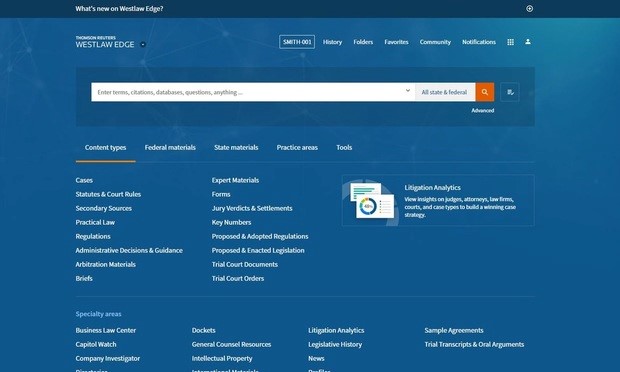Law.com Subscribers SAVE 30%
Call 855-808-4530 or email [email protected] to receive your discount on a new subscription.
Legal Tech: A Deep Dive Into the Tech Upgrades in Thomson Reuters' Westlaw Edge
Thomson Reuters is calling Westlaw Edge the company's most significant legal release since Westlaw Next in 2010, which makes sense — the features represent more than just an incremental product upgrade. Below is a non-exhaustive list of the features in the new Westlaw Edge product, as they were shown to Legaltech News and other media before the product's official release.
 The home page for Thomson Reuters' new Westlaw Edge legal research platform.
The home page for Thomson Reuters' new Westlaw Edge legal research platform.New Warnings for Invalid or Questionable Law
Case law may establish precedent, but precedent often doesn't last forever. In Westlaw Next, when a case overturned a previous ruling, the platform noted the overruled case with a red flag. What it didn't note, however, were the subsequent pieces of case law that were also invalidated by an overturned case but not explicitly mentioned in the new ruling.
Now, Westlaw Edge users will notice a new symbol: an orange triangle with an exclamation point. This means an “overruling risk,” which indicates that while a given case may not have a direct negative history, there are other issues at play, such as a cited case later being overruled.

The DOJ's Corporate Enforcement Policy: One Year Later
The DOJ's Criminal Division issued three declinations since the issuance of the revised CEP a year ago. Review of these cases gives insight into DOJ's implementation of the new policy in practice.

The DOJ's New Parameters for Evaluating Corporate Compliance Programs
The parameters set forth in the DOJ's memorandum have implications not only for the government's evaluation of compliance programs in the context of criminal charging decisions, but also for how defense counsel structure their conference-room advocacy seeking declinations or lesser sanctions in both criminal and civil investigations.

Use of Deferred Prosecution Agreements In White Collar Investigations
This article discusses the practical and policy reasons for the use of DPAs and NPAs in white-collar criminal investigations, and considers the NDAA's new reporting provision and its relationship with other efforts to enhance transparency in DOJ decision-making.

Bankruptcy Sales: Finding a Diamond In the Rough
There is no efficient market for the sale of bankruptcy assets. Inefficient markets yield a transactional drag, potentially dampening the ability of debtors and trustees to maximize value for creditors. This article identifies ways in which investors may more easily discover bankruptcy asset sales.

A Lawyer's System for Active Reading
Active reading comprises many daily tasks lawyers engage in, including highlighting, annotating, note taking, comparing and searching texts. It demands more than flipping or turning pages.

